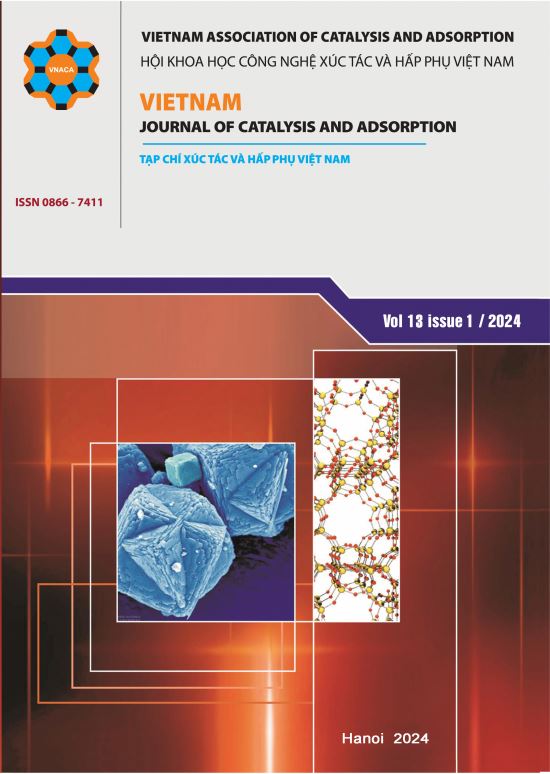Synthesis of CQDs/MIL-101(Cr) photocatalytic nanocomposite for degradation of RR-195
DOI:
https://doi.org/10.62239/jca.2024.018Keywords:
CQDs, UiO-66, RR-195 degradation, photocatalyst, nanocompositeAbstract
CQDs, characteristically quasispheroidal carbon nanoparticles composed of amorphous to crystalline carbon base, is a prospective semiconductor quantum dots owing to its excellent optical absorptivity, chemical stability, nontoxicity, and facile synthesis. In this study, we demonstrated the impregnation method to integrate CQDs, formed from chitosan with MIL-101(Cr) from terephthalic acid recycled by PET waste to synthesize CQDs/MIL-101(Cr) nanocomposite. After the hybridization of CQDs with MIL-101(Cr), the band gap energy of the 50% CQDs/MIL-101(Cr) has the lowest Eg (1.98 eV), allowing the demonstration of photocatalytic activity under high visible light. This material was tested in the photodegradation RR-195 dye and compared with the pristine components. The highest RR-195 degradation efficiency was recorded when using catalyst mass: 50 mg of 50% CQDs/MIL-101(Cr) catalyst samples, dye concentration: 50 ppm after 4 h under xenon lamp 300w was 96%. These results could promote a new material as a new semiconductor that can be used to protect water from further pollution.
Downloads
References
Pardeep Singh, Anwesha Borthakur, P.K Mishra, Dhanesh Tiwary, 2019.
Łukasz Janus, Marek Pia˛tkowski, Julia Radwan-Pragłowska, Dariusz Bogdał and Dalibor Matysek, Nanomaterials (2019). https://doi.org/10.3390/nano9020274.
Rongbin Lin, Shumin Li, Jingyun Wang, Jiapeng Xu, Chunhui Xu, Jin Wang, Chunxia Li and Zhengquan Li, Inorganic chemistry (2019). https:/doi.org/10.1039/C8QI01164H.
Xiaoyan Wei, Yawen Wang, Yu Huang, Caimei Fan, Journal of Alloys and Compounds 802 (2019) 467-476. https://doi.org/10.1016/j.jallcom.2019.06.086.
Jianwei Ren, Xoliswa Dyosiba, Nicholas M. Musyoka, Henrietta W. Langmi, Brian C. North, Mkhulu Mathe, Marice S. Onyango, International Journal of Hydrogen energy 41 (2016) 18141-18146. https://doi.org/10.1016/J.IJHYDENE.2016.08.040.
X.N. Pham, V.T. Vu, H.V.T. Nguyen, T.T.B. Nguyen, H. V. Doan, Nanoscale Advances. 4 (2022) 3600–3608. https://doi.org/10.1039/d2na00371f.
X. Zhou, W. Huang, J. Shi, Z. Zhao, q. Xia, Y. Li, H. Wang and Z. Li, J, Mater. Chem. A 2(13) (2014) 4722–4730.
D. Yin, C. Li, H. Ren, O. Shekhah, J. Liu, and C. Liang, RSC Advances 7 (3) (2017). https://doi.org/10.1039/c6ra25722d.
Z. Li, G. Che, W. Jiang, L. Liu, and H. Wang, RSC Advances 9 (7) (2019) 57. https://doi.org/10.1039/c9ra05600a.
Patrick S.Bárcia, Daniela Guimarães , Patrícia A.P. Mendes, José A.C. Silva, Vincent Guillermc, Hubert Chevreau, Christian Serre, Alírio E. Rodrigues, Micropor. Mesopor. Mat. 139 (2011) 67–73. https://doi.org/10.1016/j.micromeso.2010.10.019.
S. Ahmed, M. G. Rasul, W. N. Martens, R. Brown, and M. A. Hashib, Desalination 261 (1–2) (2010). https://doi.org/10.1016/j.desal.2010.04.06
Downloads
Published
Issue
Section
How to Cite
Share
Funding data
-
Trường Đại học Hàng hải Việt Nam
Grant numbers DT23-24.124











